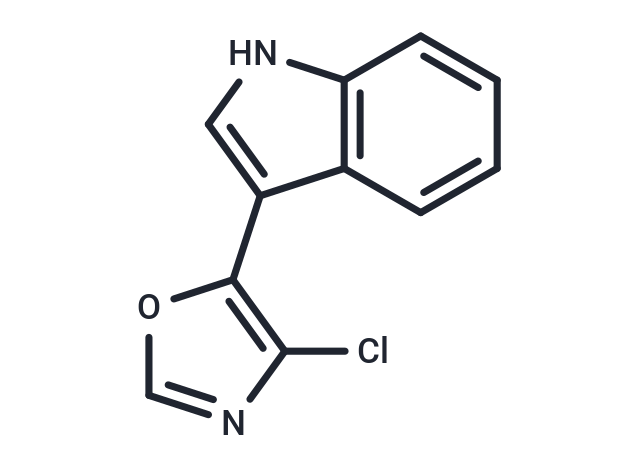- Remove All
 Your shopping cart is currently empty
Your shopping cart is currently empty
Streptochlorin
Streptochlorin is a bacterial metabolite originally isolated from Streptomyces sp. SF2583 that has diverse biological activities, including antiangiogenic, antiproliferative, and anti-allergic properties. It inhibits TNF-α-induced NF-κB transcriptional activity and decreases proliferation of human umbilical vein endothelial cells (HUVECs) when used at concentrations ranging from 5 to 20 μM. Streptochlorin (12 μg/ml) decreases viability of, as well as induces apoptosis and increases the production of reactive oxygen species (ROS) in, Hep3B human hepatocellular carcinoma cells. It does not induce cytotoxicity in RBL-2H3 mast cells at concentrations up to 100 μM. Streptochlorin prevents degranulation in antigen-stimulated mast cells, as well as inhibits Syk kinase and the Src family kinases LYN and Fyn and reduces the secretion of TNF-α and IL-4 induced by dinitrophenyl-human serum album (DNP-HSA) in RBL-2H3 mast cells. It also decreases swelling and reduces scratching behavior in a mouse model of allergic dermatitis induced by dinitrofluorobenzene (DNFB).

Streptochlorin
| Pack Size | Price | Availability | Quantity |
|---|---|---|---|
| 1 mg | $816 | 35 days | |
| 5 mg | $2,970 | 35 days |
Product Introduction
| Description | Streptochlorin is a bacterial metabolite originally isolated from Streptomyces sp. SF2583 that has diverse biological activities, including antiangiogenic, antiproliferative, and anti-allergic properties. It inhibits TNF-α-induced NF-κB transcriptional activity and decreases proliferation of human umbilical vein endothelial cells (HUVECs) when used at concentrations ranging from 5 to 20 μM. Streptochlorin (12 μg/ml) decreases viability of, as well as induces apoptosis and increases the production of reactive oxygen species (ROS) in, Hep3B human hepatocellular carcinoma cells. It does not induce cytotoxicity in RBL-2H3 mast cells at concentrations up to 100 μM. Streptochlorin prevents degranulation in antigen-stimulated mast cells, as well as inhibits Syk kinase and the Src family kinases LYN and Fyn and reduces the secretion of TNF-α and IL-4 induced by dinitrophenyl-human serum album (DNP-HSA) in RBL-2H3 mast cells. It also decreases swelling and reduces scratching behavior in a mouse model of allergic dermatitis induced by dinitrofluorobenzene (DNFB). |
| Molecular Weight | 218.64 |
| Formula | C11H7ClN2O |
| Cas No. | 120191-51-7 |
| Relative Density. | no data available |
| Storage | Powder: -20°C for 3 years | In solvent: -80°C for 1 year | Shipping with blue ice. |
| Solubility Information | DMSO: Soluble Methanol: Soluble |
Calculator
In Vivo Formulation Calculator (Clear solution)
Dose Conversion
Tech Support
Keywords

Copyright © 2015-2025 TargetMol Chemicals Inc. All Rights Reserved.




